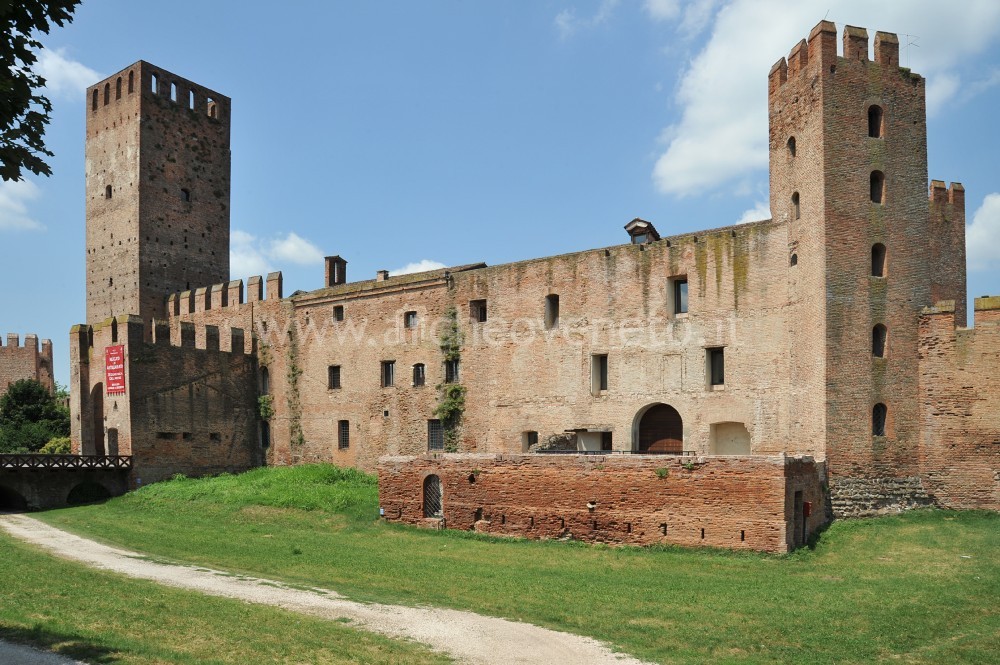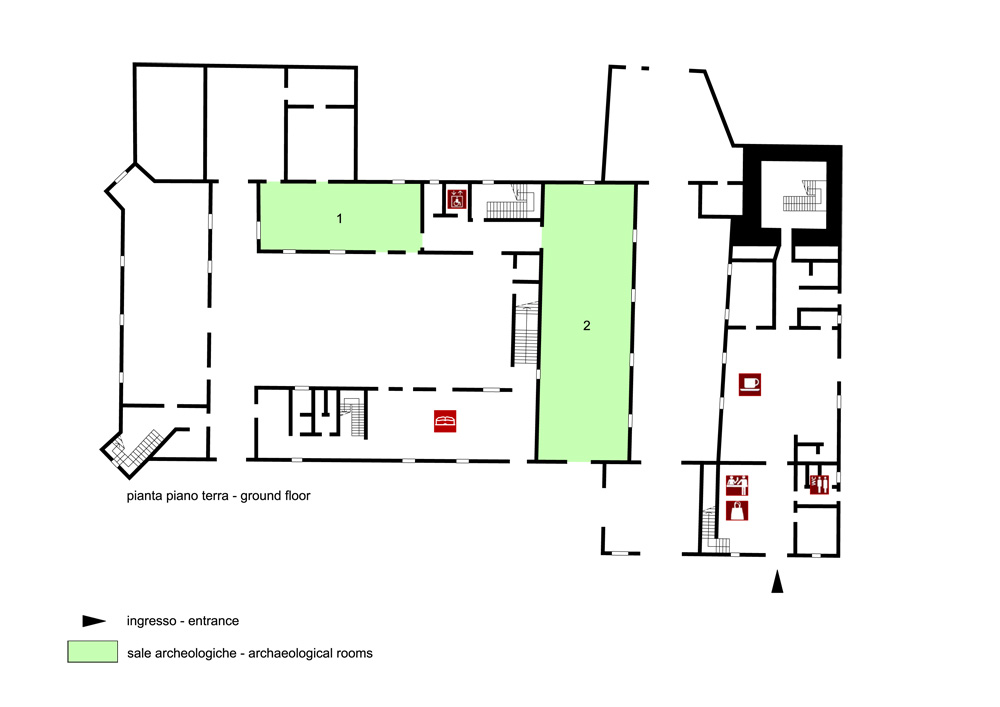| Piazza Trieste 15 (Castel San Zeno) - 35044 Montagnana (PD)
Tel. 0429 804128 - 0429 81320 - Fax 0429 804128 – 0429 81320 |
Web site http://www.comune.montagnana.pd.it |
|
Summary
The Civic Museum of Montagnana is located inside the Castle of San Zeno, which is the most ancient part of the town fortifications. It was commissioned by the feudal lord Ezzelino da Romano in 1242 and then further expanded over the following centuries by the Carraresi family and by the Most Serene Republic of Venice. The museum is composed of three different areas: the archaeological, the medieval-modern and the “Martinelli–Pertile” music sections.Collection history
The archaeological section and the lapidarium were established in 1980, following the extraordinary discovery of the Roman cemetery of the Vassidia gens (1973); this part of the museum displays the material coming from the necropolis, as well as a series of pre- and proto-historic finds and artefacts, which were found in Montagnana and in the surrounding area thanks to numerous surface analyses and excavations. In 1996, the museum compound was refurbished and it was given the layout it displays today.
|
 |  |
Room 1 The first room contains the pre-historic and proto-historic materials found in the area of Montagnana. On the right side of the entrance, there is a panel explaining the archaeological situation of the region from the 4th millennium B.C. to the Romanization (2nd century B.C.), thanks to the support of a map that shows the places in which the different materials were found. The path goes on along the right wall with a series of panels providing information on the chronological and geographical contexts of the items displayed in the cases in front of the panels. The most ancient finds date back to the neo- and eneolithic age (late 4th – early 3rd cent. B.C.) and come from the settlements in Palù and Busi. The artefacts displayed are mainly flint tools; noteworthy is the large dagger blade worked with a flat retouch.
The small village Busi has always been inhabited, also during the early Bronze age (8th-7th cent. B.C.) and the first phase of the Middle Bronze age (16th-15th cent. B.C.), as numerous items found in some waste pits prove, such as fictile tools (pots, bowls and dolia), lithic tools (pestles, cobblestones with an offset in the middle), flint tools (weapons, burins, scrapers) and deer antler tools (final part of an antler and engraved plaque), which can be traced back to the Polada Culture.
The finds of the Middle and Late Bronze Age (14th–13th cent. B.C.) come from the necropolis of Cognaro, where a group of 12 cremation graves were discovered. Each burial had a fictile ossuary (biconical or ovoid pot) containing the remains of the cremation with a covering bowl.
The second display case contains the group of finds that can be considered the most meaningful items of the museum: they come from Borgo San Zeno, a village characterised by a large settlement and a necropolis, both dating back to a time span ranging from the end of the late Bronze age to the early Iron age (12th-early 8th cent. B.C.). Thanks to the materials found and an in-depth analysis on the site it has been possible to carry out an interesting study on the domestic habits as well as on the production and manufacturing activities that took place in the village: spinning, weaving, manufacturing tools with different materials, such as clay, wood, bronze, deer bone and antler, glass.
A cremation necropolis has also been found in the village Cà Nogare - Fondo Rancan, very close to Borgo San Zeno: it dates back to the the 9th - 8th cent. B.C. and the finds mainly consist of biconical urns (used as ossuaries), covering bowls, spindle whorls, fibulae and other decorative objects, like small rings. The same display case contains finds coming from the burial chamber of a necropolis located under the dwellings of Borgo and which could be traced back to the earliest phase of the proto-historic settlement (10th -9th cent. B.C.). Only the grave goods of two tombs have been found, which show some similarities with the objects found in Frattesina di Fratta Polesine (fibulae, knife blades, metal ingots, flanged axes) thus bearing witness to the hypothesis of close business relations between the two villages.
The archaeological finds dating back to the subsequent phases of the Iron age (8th -2nd cent. B.C.) are less abundant and most of them stem from funerary contexts. The visit to the museum goes on with the exhibition of the material found in some cemeteries located just outside the town walls (in Prato della Valle, Fondo Togni, Lago Zorzi). The items displayed seem to bear witness to the very close relation with the neighbouring and powerful town Este, since they are characterized by decorative patterns very similar to those belonging to the proto-historic tradition of Este: situlate ossuary, with or without cover, displaying the typical decoration with red and black stripes (obtained by wiping the raw clay to create the contrast between shiny and dark parts), “compound eye” glass beads, jewels in gold leaf and other luxury objects.
The last part of the room displays items dating back to the late Iron age (3rd-1st cent. B.C.), even though probably as a consequence of the depopulation of the area following the Romanization, there are not many finds from this period. The archaeological site that best shows this transition phase is the necropolis of Medaglino S. Fidenzio (property of the Moro family), where the grave goods show a mix of items both in terms of quantity and quality: grave goods are composed of objects coming from the Veneto region (table pottery in the local grey clay) combined with Celtic materials (weapons and farming tools left in the burial) and Roman coins.
Particularly noteworthy is the male grave found in Montagnana, in the site of Gomoria, in which the grave goods included fictile pottery, a remarkable amount of weapons and iron tools (knives, umbos, fibulae like the “La Tène”, iron shears) and two bronze asses (Roman coins) that can be traced back to the late 2nd cent. B.C. The data provided by these necropolises show a clear picture of the settlements in Veneto, in particular between Este and Montagnana in the time span between the 3rd and 2nd centuries B.C. |
Room 2 The items displayed in the second room refer to the Roman occupation of the area of Montagnana and date back to a time span from the late 1st cent. B.C. to the 2nd cent. A.D.
The large panel placed on the right side of the room entrance explains how the area of Montagnana was organised at that time: it was rich of country villas and cemeteries and characterized by an irregular distribution of the settlements.
It remains still unknown whether the place was a vicus, a forum, a pagus or a mansio. This uncertainty regards also the name of the site, which is mentioned in numerous literary works (see Tacitus: “Forum alieni” and Mansio Anneiano: “Itinerarium Antonini”). In any case the current area of Montagnana is very likely to have been characterized by a small local and rural organizational structure. The most important archaeological finds stem from a single funerary compound located in a plot of land in via Rosa: it was the necropolis of the Vassidia gens, which can be traced back to a period between the Julio-Claudian age and the Flavian age (1st cent. A.D.). The epigraphs discovered are particularly interesting and precious, as they have enabled researchers to understand the size of the cemetery (thanks to the presence of two inscribed cambered stones and a small anepigraph pillar), the owners (through the discovery of the monumental and sumptuous funerary stele that Postumulena Sabina commissioned for herself and her beloved and that was placed at the centre of the necropolis) and the social status of the departed (thanks to the steles where the condition of either servant or freedman was indicated). In front of these inscriptions there are six large display cases, which contain the grave goods of 15 tombs discovered in 1973. The funerary objects can be classified according to the type and their symbolic value: there are highly symbolical items (decorated lamps and coins of the early imperial age that evoke the underworld); artefacts related to the issue of the funeral banquet (bottles, cups and plates both in clay and in blown glass), objects belonging to the daily activities and items of clothing (fibulae, pins, small mirrors, bronze rings, engraved gems, bronze foil mirrors, unguentaria and iron knives).
The visit to the museum ends with a further exhibition of burial materials found in the cemeteries discovered in different places and areas of Montagnana: a funerary altar from Borgo San Marco, fragments of a funerary stele from Urbana (property of the Baron and Corradin families), gravestones from Montagnana-Prato della Valle and Santa Margherita d’Adige. The last part of the room, which is also very important, displays lithic tools that seem to provide evidence for the presence of some rural communities in the area of Montagnana: there are the remains of water pipes made of trachyte, millstones for cereals and the fragment of a solar clock.
|
|
Visiting
Admission: Negli orari di apertura;
Ticket: Si;
Price: Full fare: 2.10 €; reduced fare: 1.60 € (groups of more than 10 people and children under 16 years of age); 1 € (participants in the workshop activities);
 School access School access
 Disabled access Disabled access
|
Recommended tour time (minutes): 60 |
|
Services for visitors
 Toilet Toilet Parking ParkingOn the square in front of the Castle of San Zeno  Bookshop BookshopAt the ticket office  Rest points Rest pointsChairs are located along the path  Bar/Restaurant Bar/Restaurant |
Educational Services
 Guide a stampa
Brochure
Catalogo Guide a stampa
Brochure
Catalogo Information boards Information boards Multilingual ads: Italiano Multilingual ads: Italiano Guided Tours Guided Tours  Educational activities Educational activitiesIt is possible to take part in thematic didactic workshops  Educational workshops Educational workshops Library and documentation centre Library and documentation centre |
Bibliography
| La sezione archeologica di Castel San Zeno 1987, in Quaderni di Archeologia del Veneto, III, a cura di Bianchin Citton E., De Min M., Padova, pp. 242-245. |
| Il Museo Archeologico e il Lapidario di Montagnana 1990, a cura di Bianchin Citton E., De Min M., Padova. |
| Musei d'Italia, Guida Touring Club Italiano 2003, Milano, pp. 222-223. |
| Musei e raccolte archeologiche del Veneto 2004, a cura di Di Mauro A., Dosson di Casier, pp. 62-64. |
| Bonetto J. 2009, Veneto (Archeologia delle Regioni d'Italia), Roma, pp. 408-410. |